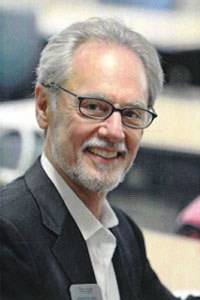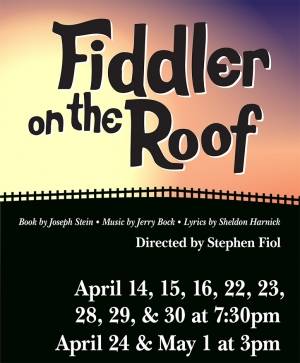Traditionally, the last production of Parkland Theatre’s season is a big musical — whether something new and splashy like last year’s The Drowsy Chaperone or familiar and beloved like this season’s Fiddler on the Roof, it always promises a spectacle. The classic musical by Jerry Bock, Sheldon Harnick and Joseph Stein will be realized under the direction of Stephen Fiol from April 14th – May 1st in the Harold and Jean Miner Theatre at Parkland College.
For those of you who know your history, Imperial Russia in 1905 might not strike you as the best time to be a traditional man who loves the simple predictability of his everyday life. Although Tevye — like those of us who have areas of expertise other than history — is unaware of the specific ways his life is about to surprise him, he is facing changes daily on both an intimate and global scale. Living with his family in a shtetl called Anatevka, the farmer tries told hold on to his Jewish traditions while thwarting the threats of violent pogroms, accidentally offending wealthy frienemies, and his eldest three daughters (of five) wanting to marry for love.
Fiddler on the Roof is an enduring musical, known to a vast audience for good reason. The musical numbers have been used throughout popular culture, ranging from catchy to humorous to reflective to startlingly thought-provoking. The Broadway run and its five revivals have been showered with Tonys, and the film adaptation was nominated for several Academy Awards and won three. And anyone growing up in the 80s had a 1 in 12 chance* of it being the Sunday matinee on the local network affiliate. It’s likely that you have run across Fiddler in some aspect of your life, at some point, even if it’s just hearing “Sunrise, Sunset” sung at a wedding. But starting this weekend, you’ll have the chance to fully experience this presentation in person, taking the time to immerse yourself in its reflections.
 To prepare to ask ourselves the unanswerable questions of Tevye, I sent a few answerable questions to director Stephen Fiol, the accomplished opera director who has taken the helm of this production.
To prepare to ask ourselves the unanswerable questions of Tevye, I sent a few answerable questions to director Stephen Fiol, the accomplished opera director who has taken the helm of this production.
Smile Politely: From a producer’s standpoint, a familiar musical often draws a large crowd and benefits the theatre. Speaking as a director, what are some of the advantages of undertaking a show that most people have heard of, and many have seen?
Stephen Fiol: The advantage is that human nature suggests that most of us like repetition and a return to the familiar. It is not by chance that symphony orchestras, ballet companies, opera companies, and theatre groups pepper their seasons with art from the cannon and familiar favorites. The disadvantage, as a director, is that many of these classic musicals have movies of the productions and cast members think they need to replicate their character as it appears in the movie or youtube.
SP: Fiddler has a relatively large cast, but most of the action and singing falls upon Tevye — what are some strategies you use to make sure all the elements gel together?
Fiol: This is certainly one of the challenges of a show such as this. Essential to the cohesion or “gel” of the production is to have a Tevye that not only works well with fellow actors on stage, but off stage as well as with the production staff so that we build cohesion and a sense of common purpose leading into a successful opening night.
 SP: This year’s season at Parkland has been all about microcosms, with each play having a world-within-a-world and often a play-within-a-play as well. Certainly the shtetl is an insular world, and the dream sequence fulfills the play-within-a-play element. What do you like or dislike about this storytelling mechanic? What ways does this specifically help Fiddler on the Roof convey its message?
SP: This year’s season at Parkland has been all about microcosms, with each play having a world-within-a-world and often a play-within-a-play as well. Certainly the shtetl is an insular world, and the dream sequence fulfills the play-within-a-play element. What do you like or dislike about this storytelling mechanic? What ways does this specifically help Fiddler on the Roof convey its message?
Fiol: The dream sequence not only resolves a dilemma for Tevye, but it further informs the audience of aspects of Tevye’s character: manipulative yet endearing. The scene presents a challenge for both the costume and lighting designer as well as the choreographer. My feeling is that The Dream enhances the story considerably by informing the viewers that these Jews of Western Russia in 1905 were superstitious as well as deeply religious. As is the case with many underprivileged cultures the significance of signs, dreams, and interpretations are elevated in their thinking.
SP: The original play’s set design and costuming was bright and vibrant, but those more familiar with the film adaptation may be expecting a drab and dreary palette. Which direction did you lean, and why?
Fiol: Chagall was the set designer/painter of the original set. It was whimsical, evocative, and vibrant as was Chagall’s artwork in general. Over the years the production has taken on a more realistic approach. Our production combines realistic as well as fanciful scenic qualities.
SP: History repeats itself, and I know that it’s quite possible for a classic play about an even earlier period in history to still be quite relevant today. What about Fiddler do you feel would still speak to a modern audience?
Fiol: The appeal and relevance of Fiddler is that it deals with what all of us eventually confront: change, the loss of the familiar and a way of knowing. For the Jews in Western Russia in 1905 it was the loss of a way of life, customs, and tradition. In today’s world change is ubiquitous and rapid and we find our anticipated way of life constantly threatened. Fiddler presents this element of life through a vivid and heartbreaking story set in the fictional town of Anatevka, Russia. But what makes this story more poignant is the fact that it is historically accurate and relevant.
SP: What else would you like our readers to know before they see your production?
Fiol: It has been said that Hitler tried to kill Judiasm and the Jews through hate and murder and that the Jewish diaspora in the United States of America, where many of the Russian and European Jews immigrated, effectively accomplished this through love. So great was the outpouring of support for the Jewish immigrant after WWII that they began to assimilate, intermarry outside of the faith, and leave the faith altogether. The shtetl life of Shalom Alechem now only lives in memory, the printed page, and in recreated works such as Fiddler.
———
Parkland’s season-closer, Fiddler on the Roof, will run from April 14th to April 30th at 7:30 p.m., with matinee-only performances held at 3 p.m. on Sunday the 24th and Sunday, May 1st. Tickets are $16 for adults, $14 for students and seniors, and $10 for youth. Thursday performances are additionally discounted, please see the details online. Tickets can be reserved through the website or by calling 217-351-2528.
About Rebecca Knaur…
Editor of Smile Politely’s Arts section, rk makes a habit of drinking mind-altering beverages while writing opinions to be published. She has a highly developed sense of grammar and syntax, but little to no content filter. You can follow her on Twitter, @rknaur, but she rarely checks it, so feel free to reiterate tweets when you see her in person.
*this is a totally made up statistic, for humorous effect.









 About Rebecca Knaur…
About Rebecca Knaur…